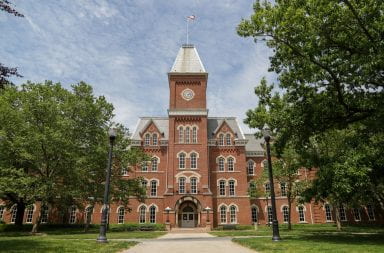
University Hall sits on the Oval near Thompson Library. Ohio State execeeded $1.36 billion in research and development expenditures in fiscal year 2022, ranking 11th among universities across the country. Credit: Lantern File Photo
After its game in November, Ohio State was beaten by Michigan again — this time in research expenditures.
The National Science Foundation’s annual Higher Education Research and Development survey ranked Ohio State 11th among all universities in the country with research expenditures — Ohio State’s exceeding $1.36 billion — in the 2022 fiscal year. The school up north ranked fourth, with expenditures at $1.77 billion.
However, the university moved up one space compared to the previous year and remained seventh among public universities.
“Ohio State’s research and creative expression community is committed to groundbreaking, convergent research that provides positive impacts for our community, state and world,” interim university President Peter Mohler said. “We are pleased that our rankings continue to improve, but are even more pleased to continue working with our partners and stakeholders to expand our research efforts and amplify their impacts.”
Though Ohio State surpassed major universities like Harvard, Columbia and the University of North Carolina, Johns Hopkins University had the highest expenditures in the survey, nearing $3.5 billion, according to the rankings.
Ohio State’s highest ranking in the survey was among industry-sponsored research, of which the university ranked sixth with nearly $142 million, according to Ohio State.
Across all universities included in the survey, research and development spending reached $97.8 billion, an $8 billion increase from the previous year. The top 30 institutions accounted for 42 percent of the total, and only 29 universities reported at least $1 billion in expenditures, according to the survey.
This data comes from 900 universities and colleges that grant at least bachelor’s degrees and expended at least $150,000 in the previous fiscal year.
According to Ohio State, the university creates 360 new inventions each year with $636 million, or 14 percent, coming from federal funds.
Though Ohio State has a diverse range of research projects, a significant one is the $22 million dedicated to a battery cell research and development center in conjunction with several government leaders and Honda, which is set to open in April 2025.
The NSF also awarded Ohio State $5 million to study the use of artificial intelligence and how it can help understand climate impacts on biodiversity, according to the university. This project brings together scientists from six different universities in the U.S. and Canada.


